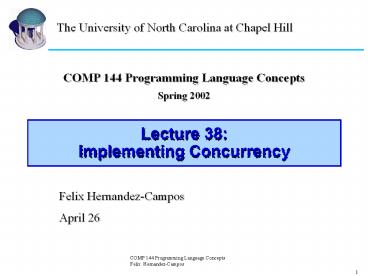COMP 144 Programming Language Concepts PowerPoint PPT Presentation
Title: COMP 144 Programming Language Concepts
1
Lecture 38 Implementing Concurrency
The University of North Carolina at Chapel Hill
- COMP 144 Programming Language Concepts
- Spring 2002
Felix Hernandez-Campos April 26
2
Concurrent Programming
Sequential Program
Concurrent Program
3
Multiprocessors
4
Shared-Memory Multiprocessor
Local cache has much lower latency
5
Threads and ProcessesOS Space versus User Space
6
Threads and ProcessesTradeoffs
- One-process-per-thread is acceptable in personal
computer with a single address space - This is too expensive in most OSes, since each
operation on them requires a system call - Processes are general-purpose, so threads may pay
the price of features they do not use - Processes are heavy-weight
- All-threads-on-one-process are acceptable in
simple languages for uniprocessors - This precludes parallel execution in a
multiprocessor machine - System call will block the entire set of threads
7
Threads and ProcessesMultiprocessors
- A multiprocessor OS may allocate processes to
processors following one the following main
strategies - Coscheduling (a.k.a. gang scheduling) attempts
to run each process in a different processor - Maximize parallelism
- Space sharing (a.k.a. processor partitioning)
give an application exclusive use of some subset
of the processors - Minimizing context switching cost and/or
communication cost
8
Coroutines
- User-level threads are usually built on top of
coroutines - Simulate parallel execution in a single processor
- p(a,b,c)
- dq(e,f) r(d,g,h)
- s(i,j)
- Coroutines are execution contexts that exist
concurrently and execute one at a time - Coroutines transfer control to each other
explicitly (by name)
9
CoroutinesExample
- Screen-saver program
- loop
- -- update picture on screen
- -- perform next sanity check
- Successive updates and sanity checks usually
depend on each other - Save and restore state of the computation
- Coroutines are more attractive for this problem
10
CoroutinesExample
- A coroutine can detach itself from the main
program - detach created the coroutine object
- Control can be transferred from one coroutine to
another - transfer saves the program counter and resumes
the coroutines specifies as a parameter - Transfers can occur anywhere in the code of the
coroutine
11
Turning Coroutines Into Threads
- The programming language environment provides a
scheduler in charge of transferring control
automatically - The scheduler chooses which threads to run first
after the the current thread yields the
processors - The scheduler may implement preemption mechanism
that suspend the current thread on a regular
basis - Make processor allocation more fair
- If the scheduler data structures are shared,
threads can run in multiple processors
12
Uniprocessor Scheduler
13
Scheduling
- reschedule is used to give up the processor
- yield is used to give up the processor
temporarily - Threads can wait on specific conditions
- sleep_on
- Intended for synchronization
14
Scheduling
- In preemptive multithreading, multiplexing does
not require to explicitly invoke yield - Switching is driven by signals
- Force the current thread to yield
- Race conditions may occur inside yield if signals
are not disabled
Preemptive Multithreading
15
Multiprocessor Scheduling
- The goal of most languages that support parallel
threads is to that there should be no difference
from the programmer point of view - This is an increasingly more important issue,
since a very significant number of machines will
be multiprocessors in the near future - At least, Intel is trying hard to do this
- Multiprocessor thread scheduling requires
additional synchronization mechanism that prevent
race conditions
16
Concurrent Programming
- The two most crucial issues are
- Communication
- Synchronization
- Communication refers to any mechanism that allows
one thread to obtain information from another - It is usually based on using shared memory or
message passing - Synchronization refers to any mechanism that
allows the programmer to control the relative
order in which operations occur in different
threads
17
Shared Memory
- Example of synchronization the semaphore
- P decrements a counter, and waits till it is
non-negative - V increments a counter, waking up waiting threads
18
Message PassingModels
- (a) processes name each other explicitly
- (b) senders name input ports
- (c) a channel abstraction
19
Ada Example
20
Reading Assignment
- Read Scott
- Sect. 12.1.3
- Sect. 12.2.4
- Sect. 8.6
- Sect 12.3 intro
- Sect. 12.4 intro

